![]()
![]()
![]()
Use LEFT and RIGHT arrow keys to navigate between flashcards;
Use UP and DOWN arrow keys to flip the card;
H to show hint;
A reads text to speech;
99 Cards in this Set
- Front
- Back
- 3rd side (hint)
|
CNS stands for.... |
Central nervous system |
|
|
|
PNS stands for... |
Peripheral nervous system. |
|
|
|
What are the two organizational structures of the nervous system? |
CNS and PNS |
|
|
|
What are the 2 functional organizations of the nervous system? |
Sensory nervous system and motor nervous system . |
|
|
|
Which direction are impulses moving in relationship to the CNS for the sensory nervous system? |
Afferent. Toward or into the CNS. |
|
|
|
Which direction are impulse's moving in relationship to the CNS for the motor nervous system? |
Efferent. Away from or out of the CNS. |
|
|
|
What are the 3 general functions of the central and peripheral nervous systems together? |
1. Collecting information. 2. Processing and evaluating information. 3. Responding to information. |
|
|
|
What are the 2 subcategories of the sensory nervous system? |
Somatic sensory and visceral sensory . |
|
|
|
What are the 2 subcategories of the motor nervous system? |
Somatic motor and autonomic motor . |
|
|
|
What information does somatic sensory deal with? |
Receives sensory information from skin, fasha, joints, skeletal muscles, and special senses such as hearing, smell, and seeing. |
|
|
|
Is the somatic sensory voluntary or involuntary? |
Voluntary. |
|
|
|
What information does visceral sensory deal with? |
Receives sensory information from viscera . (Organs) |
|
|
|
What word means organs? |
Viscera or visceral. |
|
|
|
Is visceral sensory voluntary or involuntary? |
Involuntary. |
|
|
|
What does the somatic motor system do? Voluntary or involuntary? |
Innervates skeletal muscle. Voluntary. |
|
|
|
What does the autonomic motor system do? Voluntary or involuntary ? |
Innervates cardiac muscle, smooth muscle and glands. Involuntary |
|
|
|
What word means the arriving information or incoming information? |
Afferent sensory . |
|
|
|
Which word means sending out information? |
Efferent . |
|
|
|
What are the 2 sub divisions of autonomic motor ? |
Sympathetic and parasympathetic . |
|
|
|
Describe sympathetic division . |
Fight or flight. Inhibits digestion. |
|
|
|
Describe parasympathetic division . |
Rest and Digest. Promotes digestion . |
Peaceful |
|
|
Describe neurons . |
Diva cells! Excitable cells capable of receiving, generating, and transporting nerve impulses. Nonmytotic. (They don't split to make more. ) |
|
|
|
Described Glial cells . |
Glial means glue. Non excitable. Support and protect the neurons. Like Gary! |
|
|
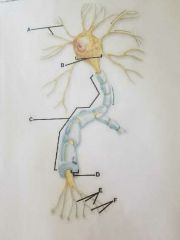
|

|
|
|
|
What do dendrites do? |
They tell the cell body where the information is coming from . |
|
|
|
What are the 3 parts of the axon? |
Telodendria, synoptic knobs, myelin sheath. |
|
|
|
What communicates with other cells away from the cell body? |
Synoptic knobs . |
|
|
|
What is the marshmallow coating around the nerves? |
Myelin sheath. |
|
|
|
What is the basic neuron structure? |
Cell body, dendrites, axon. Sub category of axon: Telodendria, synaptic knobs, myelin sheath. |
|
|
|
What are the 3 classifications of neurons based on function? |
Sensory neurons, motor neurons, interneurons. |
|
|
|
Describe sensory neurons and alternative term . |
It is an afferent neuron. They transmit impulses from receptors to the CNS. The cell bodies of most sensory neurons are located in the dorsal root ganglia in the PNS . (Clusters outside of PNS???) |
|
|
|
Described motor neurons and alternative term. |
Efferent neurons. They transmit nerve impulses from the CNS to effectors (muscles and glands). Most motor neuron cell bodies are located in the spinal cord (suburbs). |
|
|
|
Describe interneurons and alternate term. |
Association neurons. They receive impulses from other neurons. Found in the CNS. Make up most of the neurons in the CNS . |
|
|

What is this? |
??? GANGLION CELL? |
|
|
|
Define ganglion. |
A group of neuron cell bodies located in the peripheral nervous system . |
|
|
|
Define nerve tract. |
A bundle of axons found in the central nervous system . |
|
|
|
Define nucleus. |
A group of neuron cell bodies located in the central nervous system . |
|
|
|
What type of cell bodies are located in dorsal root ganglia? |
Sensory neurons??m |
|
|
|
Define nerve. |
A cable like bundle of parallel axons found in the peripheral nervous system. |
|
|

|
Glial cells. Oligodendrocyte. Found in CNS. |
|
|
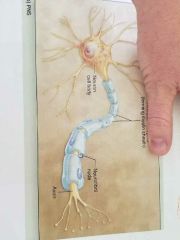
Glial |
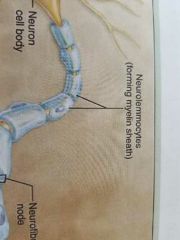
Neurolemmocytes. PNS |
|
|

Myelination of axons. Which type and how does it form the myelin sheath? |
Oligodendrocytes CNS ?????? |
|
|
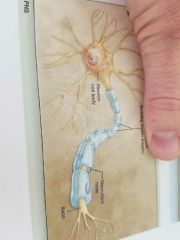
Myelination of axons . Which and how does it form the myelin sheath? |
Neurolemmocytes (Schwann cells) PNS |
|
|
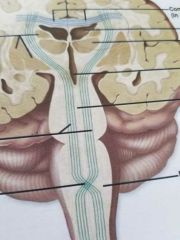
What are the blue lines |
Tract. |
|
|
|
Define effector and give examples of structures that are effectors. |
Cells that are impulsed by motor neurons. Muscles and glands. |
|
|
|
Define where the cell bodies of motor and sensory neurons are located and be able to indicate where interneurons are found. |
Sensory is in PNS. Motor is in CNS in the spinal column. Interneurons CNS. |
|
|
|
What are the 4 regions of the adult brain? |
Cerebrum, diencephalon, brainstem, cerebellum. |
|
|
|
Define Gray matter. |
Contains neuron cell bodies, dendrites, Telledendrea, unmyelinated axons. |
|
|
|
Define white matter . |
Contains myelinated axons |
|
|
|
Where is the Gray matter versus the white matter? |

Gray matter is dark outer lining (cortex) and some inner (cerebral nuclei). White matter is inner. |
|
|
|
Where is Gray and white matter in the spinal cord? |
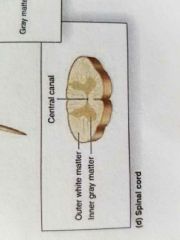
Outer white. Inner gray. |
|
|
|
Define cerebral hemisphere . |
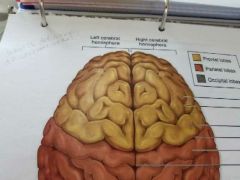
Half of cerebrum. |
|
|
|
Find cerebral cortex . |
Cortex is like the bark of a tree . Outer lining. |
|
|
|
Define sulcus in reference to the cerebrum . |
Valleys. |
|
|
|
Define gyrus in relationship to the cerebrum . |
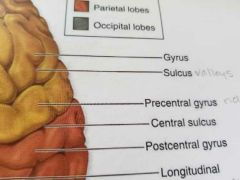
Ridges. |
|
|
|
Define Fissure in reference to the cerebrum. |
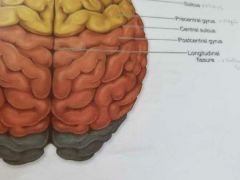
Really deep sulcus . |
|
|
|
Where is the longitudinal fissure ? |
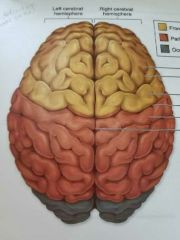
It runs down the center at the brain . |
|
|

What is the separation running transverse on the brain ? |
Central sulcus . |
|
|
|
What is the separation above the temporal lobe of the brain ? |

Lateral sulcus. |
|
|
|
What allows for to him as spears to communicate? |
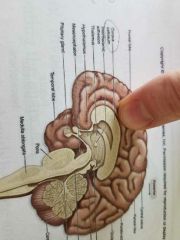
Corpus calossum |
|
|
|
What are the 5 lobes of the cerebral hemispheres? |
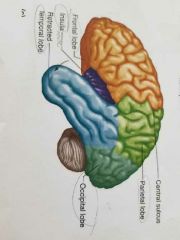
Frontal lobe. Parietal lobe. Temporal lobe. Occipital lobe. Insula. |
|
|
|
What is the function of the frontal lobe? |
Voluntary motor functions, concentration, verbal communication, Decision-making, planning, personality. |
|
|
|
Describe the functions of the parietal lobe. |
Involved with general sensory function, such as evaluating shape and texture of objects. |
|
|
|
What are the functions of the temporal lobe ? |
Involved with hearing and smell. |
|
|
|
What are the functions of the occipital lobe? |
Processes incoming visual information and stores visual memories. |
|
|
|
What is the function of the insula? |
Evolved in memory and the interpretation of taste. |
|
|
|
What is the 3 components of the Diencephalon? |
Hypothalamus, Thalamus, epithalamus. |
|
|
|
What are the functions of the epithalamus ? |
Inclued the pineal gland, which is involved in regulating the body's circadian rhythms. Produces melatonin. |
|
|
|
What are the functions of the thalamus? |
- relay points for all of the conscious senses except olfaction (smell); Forwards it to the cortex. - filter sensory input. - tells the cortex where the information came from. |
|
|
|
Explain the functions of the hypothalamus. |
- a major integration center for the autonomic nervous system. Influences heart rate blood-pressure, digestive activities and respiration. - control of the endocrine system. Endocrine Hormones. Secretes hormones that effect of the activity of the pituitary gland. - regulation of body temperature. Contains the body's thermostat. - control of emotional behavior. Involved in controlling emotional responses such as fear rage contentment etc. - control of food intake. Produces sensations of hunger - control of water intake - regulation of sleep-wake circadian rhythms. Directs the pineal gland. |
|
|
|
Identify find the pituitary gland . |
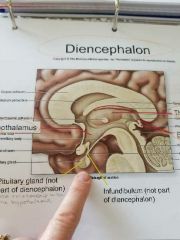
|
|
|
|
What are the 3 components of the brain-stem? |

Midbrain, pons, medula oblongata. |
|
|
|
Describe the major functions of the brain-stem as a whole. |
Contains many autonomic centers. Rate and depth of breathing, rate and strength of heart contractions, blood-pressure. Contains reflex centers. Houses nuclei for many of the cranial nerves. Involved in coughing, sneezing, salivating ,Swallowing, gagging, vomiting. |
|
|
|
What connects the brain to the spinal cord? |
The brainstem. |
|
|
|
What part of the brain is used in a sobriety test? |
Cerebellum . |
|
|
|
Be able to identify and define the cerebellum, cerebellar cortex, cerebellar hemispheres, and Arbor vitea. |
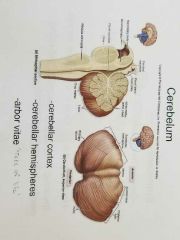
????? |
|
|
|
The major functions of the cerebellum? |
Coordinate muscle movements. smooth coordinated muscle movements. Maintains posture and equilibrium. Regulates the body's position. |
|
|
|
What are the major functions of the limbic system? |
Composed of multiple cerebral and diencephalic structures. Process and experience emotion; involved in motivation, emotion, and memory with an emotional association. |
|
|
|
Name the meninges for most superficial to deepest. |
Epidural space, dura mater, subdural space, arachnoid space, sub arachnoid space, pia mater. |
|
|
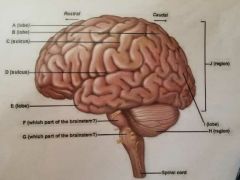
|

|
|
|
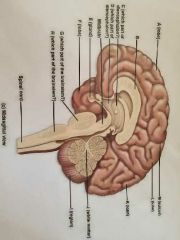
|

|
|
|
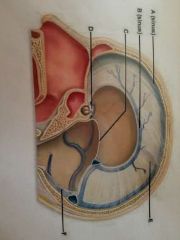
|
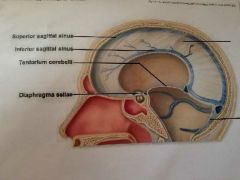
|
|
|
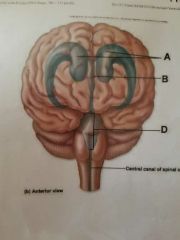
|
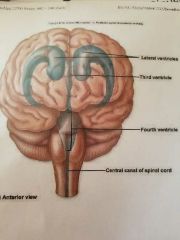
|
|
|
|
Define dural venous sinus. |
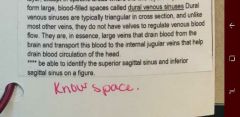
Help to drain blood from the brain. |
|
|
|
Define the term cranial dural septa. |
These membranous partition separate specific parts of the brain and provide additional stabilization and support to the entire brain . |
|
|
|
What are the four individual septas ? |
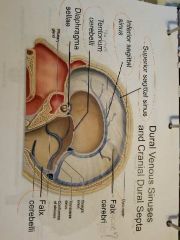
Falx cerebri, tentorium cerebelli, Falx cerebelli, diaphragma sellae |
|
|
|
List the structures in the brain each cranial dural septa is associated with (what structures do they cover or separate?) |
Falx cerebri (cerebrum) (largest, sickle-shaped, Attaches to Crista Galli, And occipital crest. ) Tentorium cerebelli (It is a tent over the cerebellum .) Falx cerebelli (Sickle shaped, divides left and right cerebellar hemispheres .) Diaphragma sellae (Forms a roof over the sella turcica, Attaches to the pituitary gland .) |
|
|
|
Defined and identify and understand the relationship to one another; lateral ventricles, 3rd ventricle, 4th ventricle, central canal. |
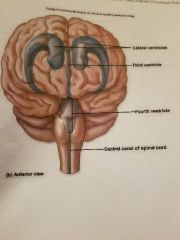
????? |
|
|
|
What are the holes in the head filled with cerebral spinal fluid? |
Brain ventricles. Lateral, 3rd, and 4th ventricles. |
|
|
|
What produces cerebrospinal fluid ? |
Choroid plexus. |
|
|
|
Defined cerebrospinal fluid. (CSF) |
??????Buoyancy, protection, environmental stability. Clear liquid that circulates in the ventricles and subarachnoid space.????? |
|
|
|
What's structure forms CSF and where is CSF formed ? |
Choroid plexus in the in ventricles. |
|
|
|
Describe and follow CSF circulation . |
Buoyancy, protection, environmental stability. Clear liquid that circulates in the ventricles and subarachnoid space.????? |
|
|
|
Define arachnoid villi and their role in CFS circulation . |
???????449-450 |
|
|
|
Where is CSF found? |
In the subarachnoid space and ventricles. |
|
|
|
Describe the function of the blood-brain barrier . |
The blood-brain barrier keeps the neurons in the brain from being exposed to some normal substances, certain drugs, waste products in the blood, and variations in levels of normal substances, like hormones, that could adversely affect brain function . |
|
|
|
What's the 12 cranial nerves in order, including their names . 1-6 |
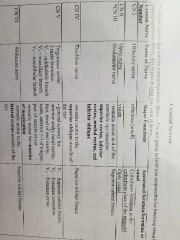
CN1. Olfactory nerve. Smell. Cribriform foramina. CN2. Optic nerve. Vision. Optic canal. CN3 oculomotor. Sematic eye motor. Superior orbital fissure. CN4. Trochlear. Superior oblique. Superior orbital fissure. CN5. Trigeminal nerve. V1 Opthalmic (sensory eyes) superior orbital fissure. V2 Maxillary . Upper jaw, top teeth) Foramen Rotundum. V3 (Muscles of mastication, lower teeth) Foramen oval. CN6. Abducens. Lateral rectus. Superior orbital fissure . |
|
|
|
Make cards for last 2 questions and objectives . |
Bbbbblllllaaaahhhh |
|
|
|
What's the 12 cranial nerves in order, including their names . |
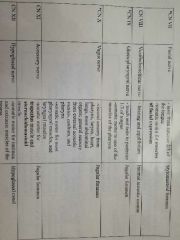
CN7. Facial nerve. Anterior 2/3 of the tongue and facial expression. Stylomastoid foramen. CN8. Vestibulocochlear nerve. Hearing and equilibrium. Internal acoustic meatus. CN9. Glossopharyngeal nerve. Posterior 1/3 of the tongue and pharnyx. Jugular foramen. CN10. Vegus nerve. Heart abdominal pharyngeal, laryngeal. Jugular foramen. CN11. Accessory nerve. Trapezius and sternocleidomastoid. Jugular foramen. CN12. Hypoglossal nerve. Muscles of the tongue. Hypoglossal canal. |
|

